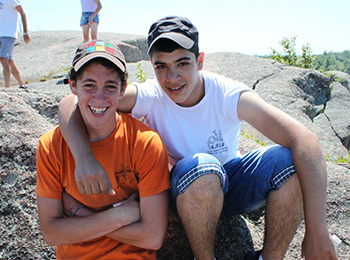Imagine sharing a room with people from a cultural group that you’ve grown up mistrusting – and even hating. This kind of living arrangement could naturally generate fear and apprehension.
And it did last summer, when a group of 20 Israeli teenagers – 10 Palestinian Israelis and 10 Jewish Israelis – spent two weeks together at Camp Shomria in Perth, Ont.
They were participants in Heart to Heart, a program founded in 2011 through a partnership between Shomria /Hashomer Hazair Canada and the Givat Haviva Education Institute in Israel. Givat Haviva runs educational programs that promote co-operation and understanding between Jewish and Palestinian Israelis.
The experience of the fourth group of Jewish and Arab teens to go to Shomria was filmed last summer in Heart to Heart, a documentary film, directed and produced by Karen Robbins and edited by Karen Shopsowitz. The film debuted in April at a Heart to Heart fundraiser held at Lula Lounge in Toronto.
The film, focuses on four of the teenagers, a pair of males and females from both the Arab and Jewish groups. In the video, all of them expressed their apprehension at the outset.
“I was really nervous about being in a cabin with Jewish and Arab girls,” recalled Sana Zahalka, one of the Palestinian Israeli girls. Towards the end of the film, she said, “At first I wanted it to end quickly. Now I don’t want it to end.”
Majd Massarwi, one of two Palestinian Israeli males, was worried he might not have anyone to talk to. “I discovered that they [the Israelis] have a lot in common with me,” he said.
These sentiments were echoed by the Jewish participants, Nir Sela and Raz Swid. They also conveyed their empathy for the Palestinian political situation. “Everybody says [tells] the history differently,” said Sela. “And we need to learn from it …”
Usnat Atamna, a Palestinian Israeli who was one of the chaperones from Givat Haviva, said the camp experience enabled the youths to transcend ethnic barriers “They saw the others as people.”
This mutual understanding is the explicit goal of Heart to Heart, according to its executive director, Dalia Krusner. She was interviewed extensively in the film. “To see the transformation these 15-year-olds go through in just over three weeks is just incredible.”
Robbins, the director of the documentary, heard about Heart to Heart in 2012 when she was on a trip to Israel.
When she was approached about doing an educational video for Heart to Heart, Robbins agreed to take on the project. It was her first major independent undertaking. “I was doing it as a volunteer. I knew it would just be me, so I was going to have to hone my camera skills.”
Much of the film captures the time she spent following the Israeli teens at Shomria. Robbins arrived there after the group’s second week, and by then the teens had congealed as a group.
In fact, the connections between them were strong enough to withstand the emotional challenges brought on by the war in Gaza last summer, Robbins recounted. “They actually all cried with each other when they heard the news.”
And the group was praised for maintaining this cohesion in a scene filmed at a community party in Toronto. “In the midst of really horrific violence, the 20 of you have managed to come together … Frankly, that’s remarkable,” Janice Stein told the teens. Stein, founding director of the Monk School of Global Affairs at the University of Toronto, was the featured speaker that evening.
After Robbins reviewed her footage, she asked the award-winning documentary filmmaker, Karen Shopsowitz, to help her edit Heart to Heart.
“I was sold on the project right away,” Shopsowitz said at the launch. “Karen’s footage was great … It was very important for the kids to tell the story.
“I was so impressed with Heart to Heart … What I like about this program is that they don’t shy away from the tough questions.”
